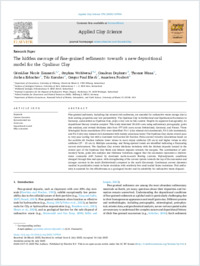The hidden message of fine-grained sediments: towards a new depositional model for the Opalinus Clay
DOKPE
- Zimmerli, Géraldine Nicole ORCID University of Fribourg
- Wohlwend, Stephan ORCID University of Bern
- Deplazes, Gaudenz National Cooperative for the Disposal of Radioactive Waste (Nagra), Wettingen, Switzerland
- Mann, Thomas Federal Institute for Geosciences and Natural Resources (BGR), Germany
- Erbacher, Jochen Federal Institute for Geosciences and Natural Resources (BGR), Germany
- Kneuker, Tilo Federal Institute for Geosciences and Natural Resources (BGR), Germany
- Eberli, Gregor Paul University of Miami, FL, USA
- Foubert, Anneleen ORCID University of Fribourg
- 2025
Published in:
- Applied Clay Science. - Elsevier BV. - 2025, vol. 276, p. 1-15
English
Fine-grained sediments, including clay mineral-rich sediments, are essential for radioactive waste storage due to their sealing properties and low permeability. The Opalinus Clay in Switzerland and Opalinuston-Formation in Germany, summarized as Opalinus Clay, plays a key role in this context. Despite its apparent homogeneity, its depositional history remains complex. This study examined 20 drill cores using sedimentary petrography, grain size analyses, and revised thickness data from 477 drill cores across Switzerland, Germany, and France. Three lithological facies associations (FA) were identified: FA-1 (clay mineral-rich dominated), FA-2 (silt dominated), and FA-3 (silt/clay mineral-rich dominated with mainly calcareous beds). The Opalinus Clay shows overall poor to very poor sorting but with a dominant well-sorted silt fraction. Paleo-current velocity calculations based on the sortable silt fraction indicate lower values in more clayey subfacies (25 cm/s) and higher values in silty subfacies (27 – 32 cm/s). Multiple coarsening- and fining-upward trends are identified indicating a fluctuating current environment. The Opalinus Clay reveals thickness variations with the thickest deposits located in the central part of the Opalinus Clay Basin and thinner deposits towards the margins. The combination of sedimentary facies, grain size analyses and thickness variations suggest that the succession represents a shallow-water contourite drift formed by dominant north-to-south flowing currents. Hydrodynamic conditions changed through time and space, with strengthening of the current system towards the top of the succession and stronger currents in the south (Switzerland) compared to the north (Germany). Continuous current dynamics resulted in predictable trends in facies evolution with relatively few small-scaled facies variations. This uniformity is essential for the effectiveness as a geological barrier and its suitability for radioactive waste disposal.
- Faculty
- Faculté des sciences et de médecine
- Department
- Département de Géosciences
- Language
-
- English
- Classification
- Earth sciences
- License
- CC BY
- Open access status
- hybrid
- Identifiers
-
- DOI 10.1016/j.clay.2025.107934
- ISSN 0169-1317
- ISSN 1872-9053
- Persistent URL
- https://folia.unifr.ch/unifr/documents/332415
Other files
Statistics
Document views: 6
File downloads:
- zimmerli_et_al_2025.pdf: 10
- supplementary_material.docx: 6

